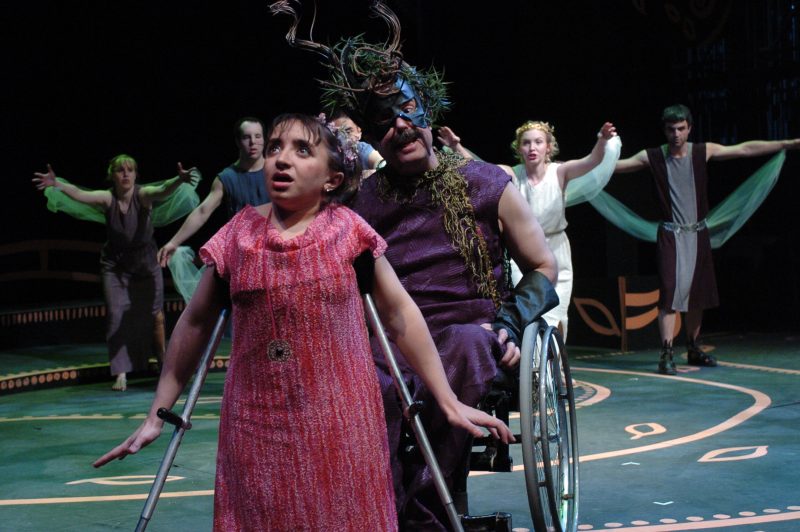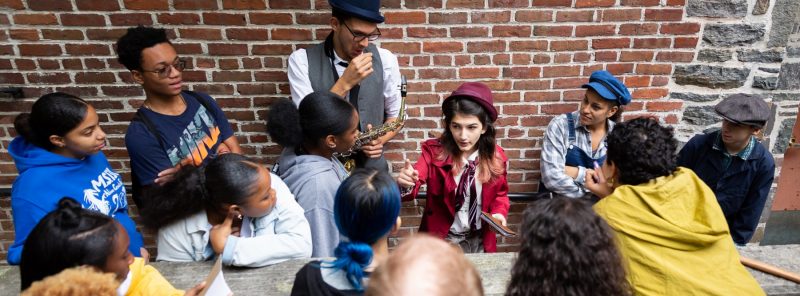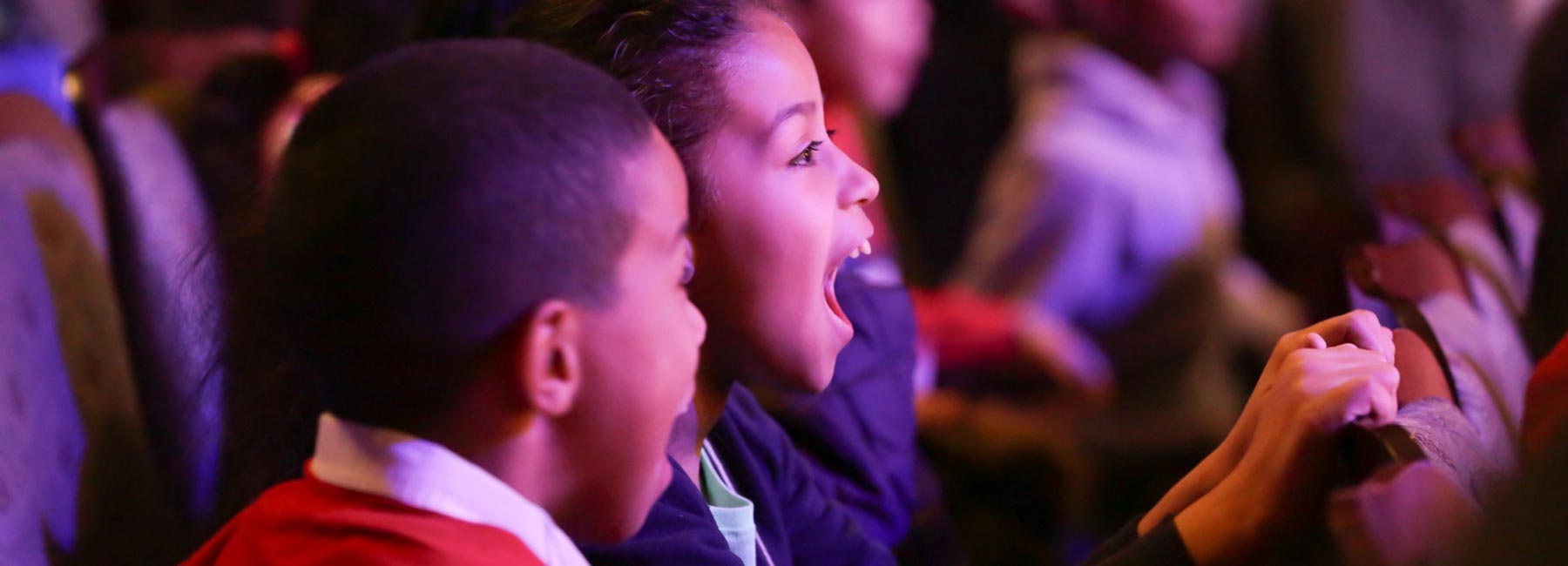There are many ways to consider “responsibility” in teaching artistry, and all of them offer unique benefits for young people engaged with teaching artists, for arts organizations and administrators, and for teaching artists themselves. In speaking with teaching artists and education directors/administrators from various contexts, the lens of trauma-informed teaching emerged as a key consideration. As Lauren Dotson, a former teacher, principal, and professor explains in her EdWeek article, “The Transformative Power of Trauma-Informed Teaching,” “At the heart of trauma-informed care is sensitivity to students’ past and current adverse experiences and a deeper understanding of why they may be acting out.” Trauma-informed teaching involves considering students’ past experiences and approaching teaching with the understanding that some students experience traumatic circumstances that may affect their current and future behavior. Teaching artists often possess incredible skills in finding creative ways to honor their students’ personal experiences. Getting to know students and finding ways to include their unique voices in performance, whether in a youth theatre ensemble or a general education classroom, comes naturally to many teaching artists. It’s exciting to highlight positive experiences, like a unique sense of humor or a desire to impact the community. It’s also important, and can be much more difficult, however, to take into account prior negative experiences, like those related to trauma.
A Unique Profession
Teaching artistry offers a particular set of opportunities and challenges. While passing along artistic knowledge to interested students has happened for centuries, the formal profession is relatively new and constantly changing. There is no perfect definition of teaching artistry and no “typical” teaching artist career trajectory. While some full-time resident teachingartists positions exist, many teaching artists piece together contracts, working with several groups of students in various contexts throughout a normal teaching day. This structure means that teaching artists shift rapidly between projects and classes, which can make taking student backgrounds into consideration tricky. Additionally, because teaching artists often work for arts organizations that partner with schools and community sites, anticipating students’ needs can prove particularly challenging. Teaching artists may have incomplete information about their students before they enter a classroom. Information about accommodations that help students be successful may be unavailable, and attendance for programs in community spaces or after-school programs tends to be less consistent than in conventional school classrooms.
All of these factors require teaching artists to simultaneously plan carefully and be incredibly flexible in their teaching. Phrases such as “meeting students where they are,” “uplifting youth voices,” and “valuing students’ life experiences” are threaded throughout the missions and practices of many theatre education organizations, and rank among teaching artists’ personal priorities as well. The factors listed earlier can make it challenging for teaching artists to achieve these goals. Still, these concepts are key for the success of teaching artists’ programs and are particularly relevant when working with students who have experienced trauma. In recent years, both education and arts sectors have placed growing attention on the idea of trauma-informed teaching, and a number of approaches to incorporating trauma-informed practices have emerged.
Before The Work: Preparing Teaching Artists For Responsible Work Through Training
Available training for careers in teaching artistry varies greatly based on geography, prior experience, and artistic discipline. While some organizations provide training that focuses on classroom management and working with specific student populations, many teaching artists work through these topics for the first time when they encounter them in the classroom. “I feel like I was dropped in the deep end, in terms of [my] own education as [a] teaching artist,” explained Kerrin Rowlands, a teaching artist from Adelaide, South Australia. “I don’t think we really had enough information about how to deal with kids with trauma for instance, or what it looked like, what the signs might be. [It would be helpful] to have basic training around what [behaviors resulting from trauma] might look like. We were having to guess.” This concern is prevalent in the US, too; American researchers Mary Elizabeth Anderson and Doug Risner describe this phenomenon as the “highly trained but less than prepared paradox,” in which artists may feel very confident (and have elevated training) in their art form, but may lack experience in teaching the artistic skills they possess or in working in classes with different needs.
Offering training, whether more broadly focused on working in schools or specifically related to working with students who have experienced trauma, can be challenging for arts organizations to facilitate for similar reasons it can be difficult for teaching artists to access. Teaching artists’ schedules vary widely, and they may not be able to commit to unpaid professional development opportunities. That said, a number of organizations are working to offer preparation for their teaching artists working with students who have experienced trauma.
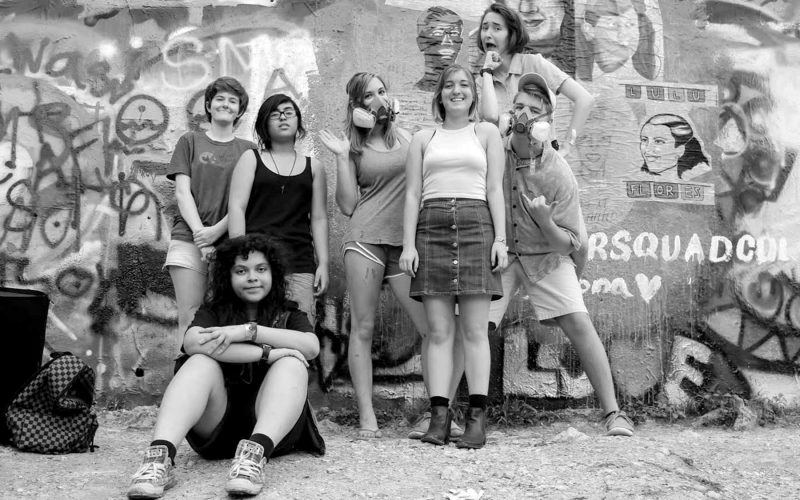
Students in Color Squad Teen Program. Creative Action, Austin, TX. Photo by Creative Action staff.
Ongoing Opportunities: Creative Action In Austin, TX
Creative Action is an arts organization in Austin, TX whose mission is “to spark and support the academic, social and emotional development of young people.” The organization offers a variety of arts-based programming, including interactive performances, in-school residencies, professional development for teachers, multiple teen programs, and long-term arts integration partnerships with schools. Creative Action contracts approximately 100 part-time teaching artists across its spectrum of programs. Many of Creative Action’s teaching artists work in multiple programs, and they are often newer to teaching artistry, explains Sarah Rinner, the senior director of Out-of-School-Time (OST) Programs. “They know how to do their art, but they may not have taught their art. A huge piece of [Creative Action’s] training model helps them understand educational concepts like the zone of proximal development and scaffolding, as well as best practices for engagement, anti-bias education, and understanding students’ needs.” Rinner goes on to underscore that their early training focuses on practical strategies for working with students.
Because Creative Action works extensively in schools, the teaching artist training series begins in late summer. The trainings Rinner described happen almost every Friday, and all Creative Action teaching artists attend somewhere between half and three-quarters of those trainings (attending a certain amount of training is required as part of their contracts). Teaching artists are paid $10/hour, which is the training rate across the organization’s programs. “We mainly focus on concrete tools that [the teaching artists] can bring into their classrooms right away, like check-ins, warm-up games, and incorporating choice and structure simultaneously. These are our onboarding processes,” explains Natalie Goodnow, Creative Action’s director of school programs. In the spring, when the teaching artists have completed a semester of programming, the sessions begin to dig deeper into ideas like trauma-informed teaching with presenters who focus on “the ‘why’ behind the practices that have been shared earlier. Hopefully there are ‘ah ha’ moments – ‘Oh, this thing I’ve been doing is trauma-informed, how great!’ If we started with those terms and big ideas, teaching artists might be overwhelmed,” Goodnow explains. This approach helps Creative Action staff focus on teaching artists’ experiences and needs.
Broad Strokes And Deep Dives: New York City Children’s Theatre
New York City Children’s Theatre (NYCCT) Director of Education Brooke Boertzel has spent considerable time developing training focused on trauma-informed practices, particularly for teaching artists who work in the company’s After-school Reading Club (ARC). The program, completing its second year in 2018, serves students in Pre-K–5th grades who live in New York City homeless shelters. “Most likely, these children have undergone some kind of trauma,” notes Boertzel. “We don’t want to assume too much about what that trauma was or how they responded to it. We do want to create a culture of compassion and openness and reflexiveness for teaching artists who go into these spaces.” To fulfill this need, the program’s teaching artists receive 15 hours of training over two years of work, with an additional 12 hours in the program’s upcoming third year. The trainings focus on various topics, including “working with students who have experienced trauma;” “understanding complex trauma and how it manifests into certain behaviors;” and how to recognize and counter unconscious and implicit biases. Additionally, the trainings offer teaching artists resources focused on stress management practices “to combat compassion fatigue” that adults working consistently with young people who have previous trauma may experience.
NYCCT teaching artists contract with the company for an academic year, and they attend new hire training when they join the program. The company also offers a refresher course for returning teaching artists. The ARC program specifically includes a pre-program training, a mid-year session, and an end-of-year session, with additional trainings specifically focused on trauma-informed practices. Boertzel explains that this structure offers inherent benefits for both the artists and the organization. In the fall, teaching artists learn about complex trauma, how trauma might impact student behavior, and ways to modify common theatre activities for students who have experienced trauma. Mid-year, teaching artists share their challenges and successes and work together to problem-solve and work through frustrations with artists from different sites. All of these trainings include a social worker and a drama therapist as part of the planning and facilitation team. Boertzel underscores the deep need for ongoing training, including a session at the end of the year that “pulls everything back in and gives context to [the teaching artists’] experience.” She also notes that this session helps the artists feel that their work is valued and gives her staff an understanding of how the program, curriculum, or training method might need to change in the future.
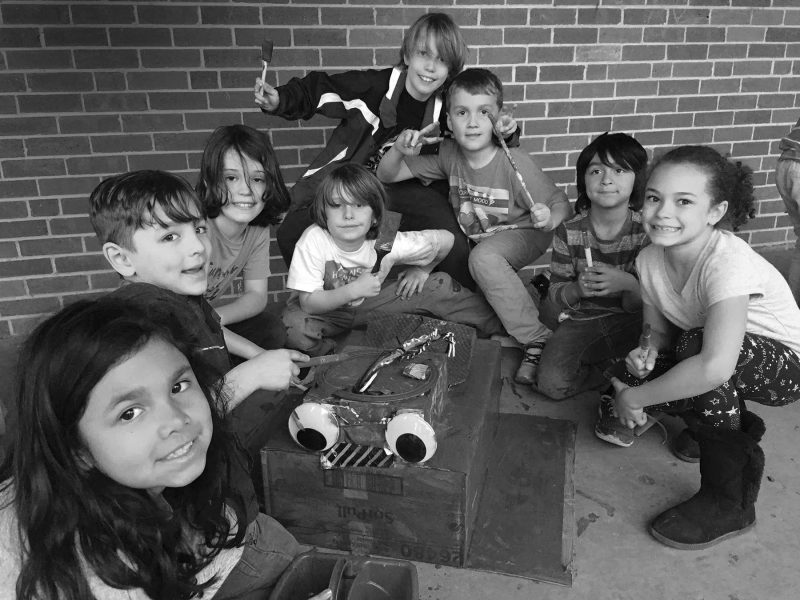
Students in Ridgetop Elementary After-School Program. Creative Action, Austin, TX. Photo by Creative Action staff.
During And After The Work: Reflexivity And Spaces For Connection
As teaching artist Kerrin Rowlands’ desire for additional preparation illustrates, training can go a long way toward building teaching artists’ confidence with their subject material and facilitation skills. However, while training that takes place before teaching artists begin working with students can be very effective, professionals from both Creative Action and NYCCT expressed the need for ongoing support and reflective spaces for teaching artists during and after their work, particularly with students who have experienced trauma.
Creative Action teaching artists work one-on-one with a coach. “[The teaching artist] can say, ‘I’m experiencing this with a kid in my class. What can I do?’ and then think about the ways they could respond. So they do have support in figuring that out for artists who are newer to teaching,” says Rinner. Second-semester trainings offer a space for teaching artists to make connections between their work and the field’s better practices, and to recognize their successes and challenges. “There’s never enough time!” Rinner said. “We could spend 50% of our training time talking about what the teaching artists experience. They really want to talk about their experiences using trauma-informed teaching, and we do try to embed time for them to talk about those experiences when they’re able to … we try to understand what their challenges are likely to be and give tools to address those specifically, like helping them be best able to address specific needs of students in a class of kids with different needs.” Her comments underscore the importance of making deliberate connections between artists’ personal experiences and the material explored through training.
NYCCT offers a social media platform for teaching artists to connect. The education staff maintains a private Facebook group for teaching artists working in the ARC program. They post weekly, sharing articles and prompts related to trauma-informed teaching and ask the artists to respond. One of the articles posted last year explored a major idea related to trauma-informed teaching: shifting from thinking, “What’s wrong with you?” when a young person acts out to “What happened to you?” as a way of more carefully considering the possible effects of trauma. These prompts “ask artists to think about how they are responding and relating to students and how the students might be relating to them,” says Boertzel. This platform also provides space for teaching artists to reflect independently while sharing their questions, concerns, and discoveries with others working within the program. “[Teaching artistry] can be a lonely profession, with lots of travel, two hours one-way on the train sometimes, with no one to really connect to on your ride home. We try to create a platform for our artists to connect; if something happens, write about it here. It allows them to feel a sense of community,” says Boertzel. Like trainings at Creative Action that offer teaching artists space to reflect on their own experiences with colleagues, this digital format offers a similar platform for teaching artists working in a geographic location that makes frequent face-to-face interactions challenging.
Practical Suggestions: Ways To Engage Trauma-Informed Teaching
As is often true of accommodations for differing abilities, trauma-informed teaching practices are advantageous not only for students who have experienced trauma, but other students as well. “The more I understand what’s successful in this work [the After-School Reading Club that takes place in homeless shelters in New York City], the more I understand that these guiding principles can be successful in every educational environment: having a plan but being willing to scrap it if it doesn’t gel with the students. Not following a strict teacher-student power relationship. Allowing students to have a voice in the direction the residency takes. Being aware of behavior in the classroom and not jumping to punitive measures if a child is distracted or not into it,” says Boertzel. “Because of this understanding, next year we will offer our entire roster of teaching artists the opportunity to participate in our trauma-informed trainings, even those not staffed directly in homeless shelters. We recognized that this training is vital and beneficial to all educators regardless of where they’re teaching because you can never be certain what kind of trauma your students may have experienced before walking into your classroom.” While the idea of trauma-informed teaching can sound intimidating initially and should not be taken lightly, many of the approaches inherent to teaching artistry align with effective practices for students who have experienced trauma.
Hallie Dizdarevic, the lead artistic associate at the Commonwealth Theatre Center in Louisville, KY, noted her career-long focus on addressing the needs of individual students as the foundation of her trauma-informed practice. As effects of trauma manifest differently in different people, addressing individual students’ needs is particularly beneficial for students who have experienced trauma, and also benefits the broader student population.
Dizdarevic began to focus specifically on trauma-informed teaching after becoming a foster parent, which “thrust into sharp focus the prevalence of trauma in every classroom, the way it affects the developing brain, and the need to thoughtfully accommodate children who have experienced high levels of trauma at an early age,” she explains. She and her colleague Letitia Usher, a teaching artist with the Commonwealth Theatre Center, Actors Theatre of Louisville, and VSA Kentucky, created and shared a list of trauma-informed guidelines at the American Alliance for Theatre and Education’s 2018 Best Practices: Inclusive and Accessible Theatre Symposium. Their recommendations from this session, along with those gathered from other interviewees for this article, form a list of practices that can benefit young people who have experienced trauma and other students in their classes. Teaching artists can apply these principles to their artistic discipline and consider the ways that they can make accommodations within teaching their art form to support students who have experienced trauma.

